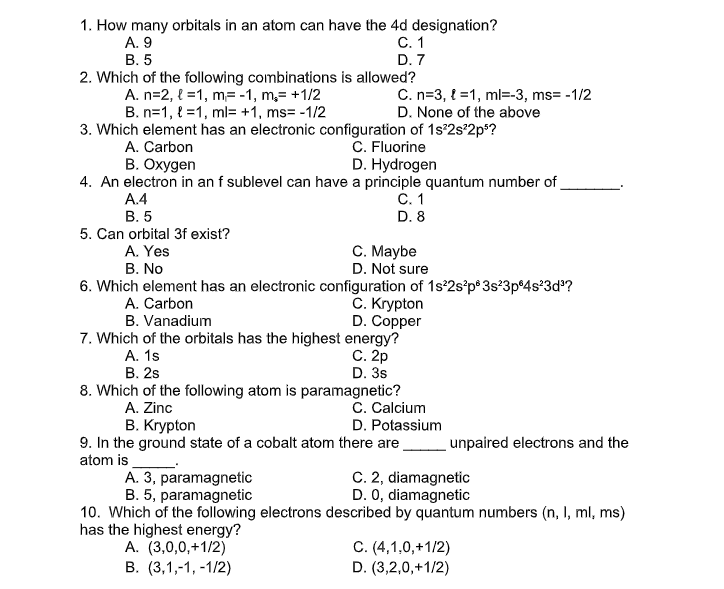1. How many orbitals in an atom can have the 4d designation? A. 9 В. 5 2. Which of the following combinations is allowed? A. n=2, { =1, m= -1, m,= +1/2 B. n=1, { =1, ml= +1, ms= -1/2 3. Which element has an electronic configuration of 1s 2s°2p*? A. Carbon B. Oxygen 4. An electron in an f sublevel can have a principle quantum number of A.4 В. 5 С. 1 D. 7 C. n=3, { =1, ml=-3, ms= -1/2 D. None of the above C. Fluorine D. Hydrogen С. 1 D. 8 5. Can orbital 3f exist? A. Yes В. No 6. Which element has an electronic configuration of 1s°2s°p®3s°3p®4s°3d®? C. Maybe D. Not sure C. Krypton D. Copper 7. Which of the orbitals has the highest energy? С. 2р D. 3s 8. Which of the following atom is paramagnetic? C. Calcium D. Potassium 9. In the ground state of a cobalt atom there are A. Carbon B. Vanadium А. 1s В. 2s A. Zinc В. Кгуpton unpaired electrons and the atom is C. 2, diamagnetic D. 0, diamagnetic A. 3, paramagnetic B. 5, paramagnetic 10. Which of the following electrons described by quantum numbers (n, I, ml, ms) has the highest energy? A. (3,0,0,+1/2) B. (3.1.-1. -1/2) C. (4,1,0,+1/2) D. (3.2.0.+1/2)
1. How many orbitals in an atom can have the 4d designation? A. 9 В. 5 2. Which of the following combinations is allowed? A. n=2, { =1, m= -1, m,= +1/2 B. n=1, { =1, ml= +1, ms= -1/2 3. Which element has an electronic configuration of 1s 2s°2p*? A. Carbon B. Oxygen 4. An electron in an f sublevel can have a principle quantum number of A.4 В. 5 С. 1 D. 7 C. n=3, { =1, ml=-3, ms= -1/2 D. None of the above C. Fluorine D. Hydrogen С. 1 D. 8 5. Can orbital 3f exist? A. Yes В. No 6. Which element has an electronic configuration of 1s°2s°p®3s°3p®4s°3d®? C. Maybe D. Not sure C. Krypton D. Copper 7. Which of the orbitals has the highest energy? С. 2р D. 3s 8. Which of the following atom is paramagnetic? C. Calcium D. Potassium 9. In the ground state of a cobalt atom there are A. Carbon B. Vanadium А. 1s В. 2s A. Zinc В. Кгуpton unpaired electrons and the atom is C. 2, diamagnetic D. 0, diamagnetic A. 3, paramagnetic B. 5, paramagnetic 10. Which of the following electrons described by quantum numbers (n, I, ml, ms) has the highest energy? A. (3,0,0,+1/2) B. (3.1.-1. -1/2) C. (4,1,0,+1/2) D. (3.2.0.+1/2)
Chapter7: Atomic Structure And Periodicity
Section: Chapter Questions
Problem 144AE: Although no currently known elements contain electrons in g orbitals in the ground state, it is...
Related questions
Question

Transcribed Image Text:1. How many orbitals in an atom can have the 4d designation?
A. 9
C.1
В. 5
2. Which of the following combinations is allowed?
A. n=2, { =1, m=-1, m,= +1/2
B. n=1, { =1, ml= +1, ms= -1/2
D. 7
C. n=3, { =1, ml=-3, ms= -1/2
D. None of the above
3. Which element has an electronic configuration of 1s°2s°2p*?
C. Fluorine
D. Hydrogen
A. Carbon
B. Oxygen
4. An electron in an f sublevel can have a principle quantum number of
A.4
С. 1
В. 5
D. 8
5. Can orbital 3f exist?
C. Maybe
D. Not sure
A. Yes
В. No
6. Which element has an electronic configuration of 1s°2s°p® 3s°3p®4s*3d?
C. Krypton
D. Copper
7. Which of the orbitals has the highest energy?
С. 2р
D. 3s
A. Carbon
B. Vanadium
А. 1s
В. 2s
8. Which of the following atom is paramagnetic?
C. Calcium
D. Potassium
A. Zinc
В. Кгуpton
9. In the ground state of a cobalt atom there are
atom is
unpaired electrons and the
C. 2, diamagnetic
D. 0, diamagnetic
A. 3, paramagnetic
B. 5, paramagnetic
10. Which of the following electrons described by quantum numbers (n, I, ml, ms)
has the highest energy?
A. (3,0,0,+1/2)
В. (3,1,-1, -1/2)
C. (4,1,0,+1/2)
D. (3,2,0,+1/2)
Expert Solution
This question has been solved!
Explore an expertly crafted, step-by-step solution for a thorough understanding of key concepts.
Step by step
Solved in 4 steps with 2 images

Knowledge Booster
Learn more about
Need a deep-dive on the concept behind this application? Look no further. Learn more about this topic, chemistry and related others by exploring similar questions and additional content below.Recommended textbooks for you


Chemistry
Chemistry
ISBN:
9781305957404
Author:
Steven S. Zumdahl, Susan A. Zumdahl, Donald J. DeCoste
Publisher:
Cengage Learning

Chemistry: An Atoms First Approach
Chemistry
ISBN:
9781305079243
Author:
Steven S. Zumdahl, Susan A. Zumdahl
Publisher:
Cengage Learning


Chemistry
Chemistry
ISBN:
9781305957404
Author:
Steven S. Zumdahl, Susan A. Zumdahl, Donald J. DeCoste
Publisher:
Cengage Learning

Chemistry: An Atoms First Approach
Chemistry
ISBN:
9781305079243
Author:
Steven S. Zumdahl, Susan A. Zumdahl
Publisher:
Cengage Learning

Chemistry: The Molecular Science
Chemistry
ISBN:
9781285199047
Author:
John W. Moore, Conrad L. Stanitski
Publisher:
Cengage Learning

General Chemistry - Standalone book (MindTap Cour…
Chemistry
ISBN:
9781305580343
Author:
Steven D. Gammon, Ebbing, Darrell Ebbing, Steven D., Darrell; Gammon, Darrell Ebbing; Steven D. Gammon, Darrell D.; Gammon, Ebbing; Steven D. Gammon; Darrell
Publisher:
Cengage Learning

Chemistry for Engineering Students
Chemistry
ISBN:
9781337398909
Author:
Lawrence S. Brown, Tom Holme
Publisher:
Cengage Learning